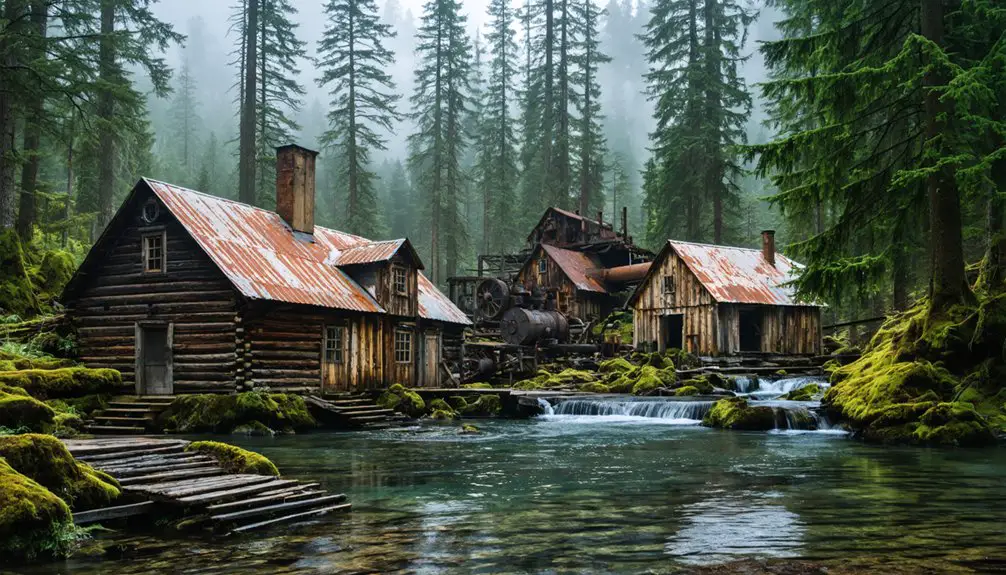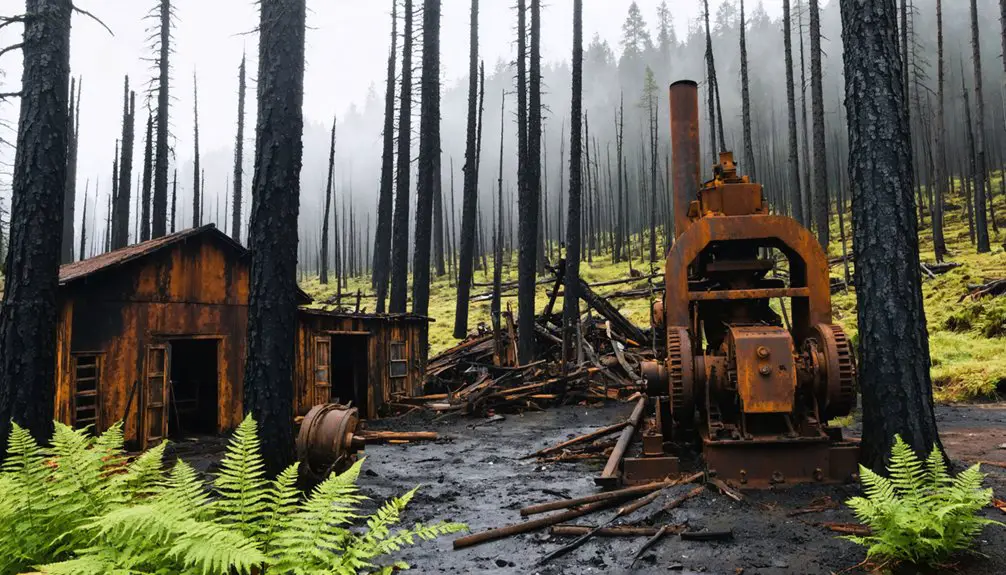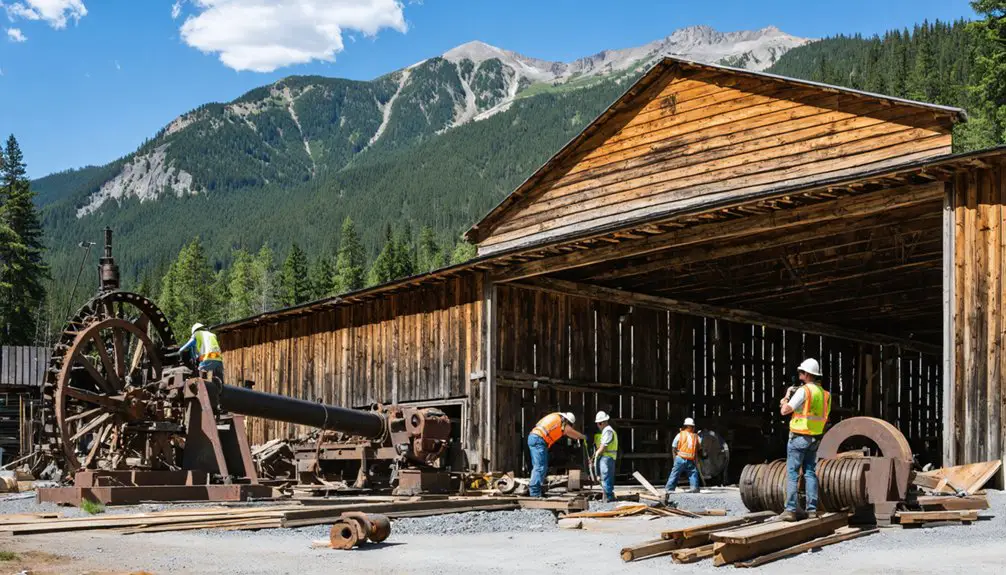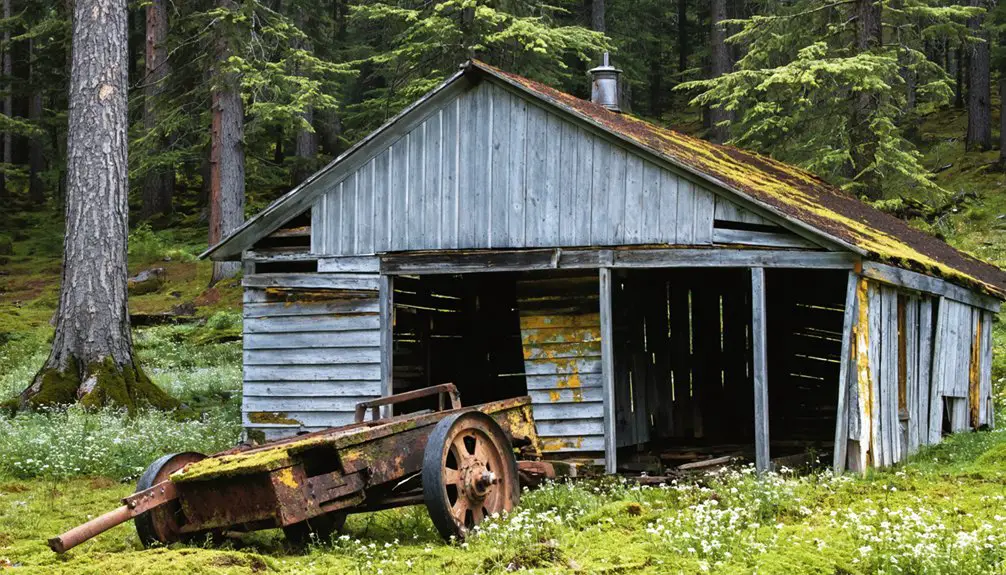You’ll discover Jawbone Flats nestled in Oregon’s Willamette National Forest, where a 1930s mining settlement thrived until 1951. The Amalgamated Mining Company established this remote camp, extracting lead, zinc, copper, and silver from the surrounding mountains. After mining ceased, the site transformed into a preserved ghost town in 1992 through Friends of Opal Creek. While the 2020 Beachie Creek Fire damaged portions of the area, original Depression-era structures and mining equipment still tell compelling stories of Oregon’s industrial past.
Key Takeaways
- Jawbone Flats began as a mining settlement in 1930, established by the Amalgamated Mining Company for lead, zinc, copper, and silver extraction.
- The site became a ghost town after mining operations ceased in 1951, following two decades of successful mineral extraction.
- Historic structures from the 1930s Depression era, including cookhouses and community halls, remain preserved at the former mining camp.
- In 1992, the land was donated to Friends of Opal Creek, transforming the ghost town into an environmental education center.
- The 2020 Beachie Creek Fire damaged much of the area, but some historic structures survived and rebuilding efforts continue.
The Rise of a Mining Settlement
While Native Americans of the Santiam Kalapuya tribe had long used the area for vision quests and trade routes, Jawbone Flats’ mining history began in 1859 when prospectors first discovered gold in the North Santiam mining district.
You’ll find the real turning point came in 1896 with the discovery of the Amalgamated Mine, where geological formations yielded rich deposits of lead, zinc, copper, and silver.
Mining techniques remained basic and production sporadic until 1930, when James P. Hewitt’s Amalgamated Mining Company established a permanent settlement. They built a modern ball mill for ore crushing and processing facilities, transforming the rugged valley into a bustling mining camp. The camp continued to thrive until Shiny Rock Mining Co. took over operations, paving the way for future conservation efforts. The mining operations continued successfully for over two decades until the camp’s activities finally ceased in 1951.
From Gold Rush to Ghost Town
After nearly a century of mining operations, Jawbone Flats’ golden era came to an abrupt end in 1951 when the Amalgamated mine shut down its operations.
Jawbone Flats’ century-long mining reign ended suddenly in 1951, silenced by the closure of Amalgamated’s industrial operations.
The Gold Creek Bridge completion in 1939 had made the remote mining settlement more accessible than ever before.
Heavy winter snowfall in the 1950s made mining operations increasingly difficult to maintain.
You’ll find that while Shiny Rock Mining Company maintained minimal claims through the 1970s, their mining techniques had evolved from large-scale extraction to mere claim preservation.
By 1992, this once-bustling mining settlement transformed into a ghost town when Shiny Rock donated the land to Friends of Opal Creek.
Today, you can explore three distinct remnants of this historic site:
- Restored 1930s buildings now serving as guest lodging and educational facilities
- Preserved mining equipment including ore cars, boilers, and Pelton wheels
- A functioning hydroelectric generator building that still powers the settlement off-grid
Life in the Mining Camp
When you tour Jawbone Flats today, you’ll find remarkably preserved Depression-era structures from 1930, including the cookhouse and community hall where miners once gathered after their shifts.
The camp’s eleven original buildings showcase the mining company’s investment in worker amenities, with features like public showers and a small hydroelectric plant that powered the remote settlement. The Beachie Creek Fire in September 2020 destroyed several of these historic structures.
You can still see the historic ball mills and Pelton Wheels that miners used to process copper, lead, zinc, and silver ores during the camp’s operation from 1930 to 1951.
Daily Camp Operations
Throughout the 1930s, daily life at Jawbone Flats centered on the steady rhythm of ore processing and mining operations. You’d find camp activities revolving around the processing of copper, lead, zinc, and silver, with workers gathering for communal meals at the cookhouse between shifts.
The hydroelectric plant, supplemented by solar power, kept operations running smoothly in this off-grid mountain setting.
Key features of daily operations included:
- Ore transport using vintage trucks and rail cars to move materials to the processing facilities
- Regular maintenance of essential equipment like boilers, Pelton Wheels, and the ball mill
- Coordinated shift changes at the communal facilities, including the cookhouse and public showers
The camp’s infrastructure, expanded under James P. Hewitt’s management, supported these daily routines that kept Jawbone Flats productive and operational.
Work and Living Conditions
Life at Jawbone Flats extended far beyond the daily mining operations, shaping a tight-knit community where miners and their families carved out existence in the remote Oregon wilderness.
You’d find modest housing centered around communal facilities – a cookhouse, public showers, and a community hall where residents gathered to strengthen their bonds.
Despite workplace hazards common to 1930s-1970s mining – including exposure to lead, zinc, and copper – the community’s resilience showed through their shared experiences.
The small population weathered isolation and basic living conditions, finding strength in family ties.
After James P. Hewitt’s 1939 infrastructure improvements, including the Gold Creek Bridge, you’d see an expanded camp with better accessibility.
The mining families’ determination to maintain their claims within National Forest boundaries kept this rugged outpost alive for decades.
Natural Wonders of Opal Creek
You’ll discover some of North America’s oldest trees at Opal Creek, where ancient giants over 1,000 years old tower above emerald-colored streams flowing over green rocks.
The pristine waters and intact old-growth forest create a critical sanctuary for diverse wildlife, including black bears, cougars, and the endangered spotted owl.
The dense canopy of Douglas fir, Western hemlock, and Pacific silver fir provides essential shelter for countless species that thrive in this remote wilderness surrounding Jawbone Flats. The steep rugged hillsides create challenging terrain that helps maintain the area’s pristine and untouched character. Regular washouts and rockslides along access roads remind visitors of the region’s wild and untamed nature.
Ancient Old-Growth Trees
Among the most remarkable features of Opal Creek’s wilderness stands a majestic collection of ancient conifers, with some western redcedars and Douglas firs dating back over 1,000 years. The forest is part of Cascadia’s largest remaining low-elevation ancient rainforest system.
These giants have weathered centuries of change, creating one of the Pacific Northwest’s richest old growth ecology zones. You’ll find these forest sentinels particularly concentrated in Cedar Flats, where specimens can reach diameters of over 17 feet. Similar to the Arcadia Cedar Grove, this area showcases some of Oregon’s most impressive coastal old-growth specimens.
- Ancient trees provide critical habitat supporting rare amphibians and diverse moss species in the region’s 70-100 inches of annual rainfall.
- The forest’s ancient biodiversity represents the last remaining low-elevation old-growth ecosystem of its size in Oregon.
- These resilient giants have survived three major fires since 1550, protected by cool, moist microclimates that characterize the area.
Crystal Clear Waters
While ancient forests dominate the landscape above, Opal Creek‘s pristine waters create an equally mesmerizing spectacle below.
You’ll find crystal-clear pools shimmering with emerald hues, their clarity maintained by the surrounding old-growth forest’s natural filtration. These jewel-like waters, averaging 50 degrees Fahrenheit year-round, offer a revitalizing escape for those bold enough to brave the chill. Some adventurous visitors enjoy jumping from rocky cliffs.
Throughout the creek, you’ll discover natural swimming holes flanked by rocky cliffs, perfect for aquatic recreation during warmer months.
The most striking features include Opal Pool and Three Pools, where deep, reflective waters invite exploration.
Even after the 2020 Beachie Fire‘s impact, many of these pristine pools remain intact, though some access points now require extra caution or remain temporarily closed.
Diverse Wildlife Habitat
The ancient forests of Opal Creek provide sanctuary to an extraordinary array of wildlife, from threatened northern spotted owls to specialized woodpeckers that carve distinctive holes in standing dead trees.
You’ll discover a thriving ecosystem where wildlife conservation efforts have preserved critical habitats since the area’s wilderness designation in 1996.
Through biodiversity monitoring, scientists have documented:
- Standing dead trees that shelter flying squirrels, bats, and endangered northern spotted owls
- Crystal-clear waters teeming with native salmon, steelhead, and the rare Oregon chub
- Rich layers of fungi, mosses, and lichens that create specialized microhabitats throughout the forest floor
As you explore Jawbone Flats, you’ll witness how this ghost town’s untouched surroundings continue supporting diverse species within its old-growth sanctuary.
Legacy of the Santiam Kalapuya
Indigenous stewards of the Santiam River valleys, the Santiam Kalapuya people inhabited and shaped this landscape for over 8,000 years before European contact.
You’ll find traces of their Santiam culture in the ancient camas ovens and obsidian tools that still dot the region, evidence of their sophisticated land management practices.
The tribe’s deep connection to this land emerges in the passionate speeches of Chiefs Tiacan and Alquema during the 1851 treaty councils at Champoeg.
Leaders Tiacan and Alquema voiced their people’s profound bond with ancestral lands during the pivotal 1851 Champoeg negotiations.
Despite their determination to retain territory between the Santiam River forks, epidemics had already devastated their population.
By 1833, diseases had claimed 90% of their people.
Their Santiam history took a tragic turn when, after failed treaties, survivors were forcibly relocated to reservations, leaving behind millennia of sustainable stewardship in these valleys.
Preservation Efforts and Environmental Education

Despite enduring the devastating 2020 Beachie Creek Fire, Jawbone Flats stands as a tribute to environmental resilience and education in Oregon’s Opal Creek Wilderness.
You’ll find a remarkable blend of historical preservation and educational outreach at this former mining town, where sustainable off-grid systems power innovative environmental stewardship programs.
The site’s commitment to wilderness education includes:
- Hands-on learning experiences that explore human-environment interactions
- An outdoor museum featuring preserved mining equipment and interpretive trails
- Leadership programs focused on real-world conservation challenges
You can explore this unique setting where pristine old-growth forests meet mining heritage, all while learning about watershed protection and forest conservation through immersive experiences.
The site’s solar and hydro power systems demonstrate how modern sustainability practices can harmonize with wilderness preservation.
Mining Relics and Historical Artifacts
Mining relics scattered across Jawbone Flats tell a compelling story of industrial ambition dating back to 1859, when gold discoveries first drew prospectors to the Little North Santiam River valley.
You’ll find remnants of mining technology throughout the site, from an ore car near former operations to the impressive Merten Mill’s brick-supported boiler from the 1940s.
The area’s cultural significance runs deeper than its mining past. Indigenous artifacts, including stone points and lithic scatters dating back 2,000 years, reveal the Kalapuya and Molalla peoples’ presence long before the miners arrived.
Later, the Amalgamated Mining Company established operations in 1930, processing lead, zinc, copper, and silver until snow damage in the 1950s largely ended industrial activities.
The CCC-reconstructed Gold Creek Bridge and deteriorating mine buildings stand as silent witnesses to this rich history.
The 2020 Beachie Creek Fire’s Impact

The devastating Beachie Creek Fire transformed Jawbone Flats and its surrounding wilderness in 2020, consuming nearly 200,000 acres of the Opal Creek region.
The fire’s impact was particularly severe after September 7, when strong east-west winds accelerated its spread, forcing evacuations and closure of Highway 22.
Key changes you’ll notice in Jawbone Flats today:
- Burned timber valued at $7.5 billion across medium to high severity areas
- Damaged infrastructure including power lines and historic mining structures
- Ongoing hazards from compromised trees and unstable ground conditions
Recovery strategies continue through the Burned Area Emergency Response program, which focuses on protecting both the site’s heritage and natural resources.
You’ll find stabilization measures throughout the area, including erosion control systems and reforestation efforts that aim to preserve this historic mining settlement for future generations.
Off-Grid Living in the Ancient Forest
Beyond the fire-scarred landscape, a thriving off-grid community has found its home within Jawbone Flats’ ancient forest.
You’ll discover 400 acres of sustainable living spaces where 31 residents have embraced forest stewardship through natural building practices and renewable energy systems.
The community’s off-grid sustainability shines through its innovative structures – from hobbit cottages to treehouses – built using locally harvested wood and natural materials.
You’ll find hybrid solar-wood energy systems powering homes, while year-round creeks and springs provide clean water through underground storage systems.
Just 25 minutes from Ashland, this intentional community balances seclusion with accessibility.
Residents maintain trails through old-growth forests, practice foraging, and cultivate a deeper connection to the land through meditation and stargazing.
Rebuilding a Historical Landmark

After the devastating 2020 Beachie Creek Fire destroyed nearly all of Jawbone Flats’ historic structures, you’ll find only one surviving cabin among the remnants of this 1929 mining settlement.
The Opal Creek Ancient Forest Center now leads reconstruction efforts, focusing on rebuilding cabins and facilities that’ll serve as both a historic center and outdoor mining museum.
You can witness the careful balance between preserving mining-era artifacts and incorporating resilient, sustainable features like solar power and hydroelectric systems in the rebuilding process.
Post-Fire Recovery Efforts
Since devastating wildfires swept through Jawbone Flats in 2020, extensive recovery efforts have focused on rebuilding this historic mining settlement while preserving its cultural heritage.
You’ll find fire resilience strategies informed by the area’s natural burn cycles dating back to 1550, while community involvement drives the careful restoration process.
Here’s what survived the 2020 Beachie Creek Fire:
- Cabin 4 – the lone original structure still standing
- The outdoor classroom facility
- The water treatment infrastructure
The rebuild incorporates sustainable materials while maintaining historical accuracy, guided by detailed records from 1929.
You’ll see the restoration prioritizing the site’s mining-era character, with plans to showcase preserved artifacts and rebuild essential facilities within the Opal Creek Wilderness boundaries.
Community Support and Funding
The rebuilding of Jawbone Flats stands as a demonstration to grassroots community action, spearheaded by the Opal Creek Ancient Forest Center (OCAFC) since the devastating 2020 fires.
You’ll find community fundraising efforts that started with the “Friends of Opal Creek” in 1989, which later evolved into OCAFC, leading the charge to preserve this historic mining settlement.
The site’s revival draws strength from diverse funding sources, including a significant $12.6 million land gift from Shiny Rock Mining Co. in 1992.
Today’s volunteer initiatives combine skilled labor with community work parties, while partnerships with the U.S. Forest Service and local businesses guarantee sustainable reconstruction.
Through educational programs, guided hikes, and hands-on workshops, you’re invited to join a movement that’s keeping Jawbone Flats’ legacy alive.
Preserving Historical Architecture
Preserving Jawbone Flats’ historical architecture requires meticulous attention to Secretary of Interior Standards while honoring the site’s mining-era legacy.
You’ll find conservation techniques focused on maintaining the architectural integrity of original wooden structures, metal roofing, and period-specific hardware that defined this 1930s mining community.
- Original materials like hand-hewn timbers and corrugated metal panels are carefully documented and repaired rather than replaced.
- Historic preservation methods protect character-defining features including miners’ cabins, the machine shop, and community buildings.
- Rehabilitation work incorporates subtle modern reinforcements while keeping the authentic weathered appearance that tells Jawbone Flats’ story.
When you explore these preserved structures, you’re experiencing authentic mining-era craftsmanship through thoughtful restoration that maintains the site’s rugged industrial heritage.
Frequently Asked Questions
What Are the Best Months to Visit Jawbone Flats?
You’ll find the best seasons from April through October, when weather conditions are favorable for hiking and exploring. Summer months (June-August) offer warmer temperatures ideal for swimming and outdoor activities.
Are Pets Allowed on the Hiking Trails to Jawbone Flats?
Yes, you can bring your dogs on the trails but must keep them leashed. The hiking regulations require following pet-friendly policies to protect wildlife and other visitors while exploring.
How Long Does It Take to Hike to Jawbone Flats?
You’ll be on your feet for about 2-3 hours round-trip, depending on your hiking style and trail conditions. The moderate difficulty level and scenic stops along old logging roads can extend your journey.
Can Visitors Stay Overnight in Any Remaining Structures at Jawbone Flats?
No, you can’t stay overnight in any structures at the site. The 2020 Beachie Creek Fire destroyed all historical accommodation options, including the rustic cabins that once offered wilderness lodging experiences.
What Wildlife Can Visitors Commonly Encounter Around Jawbone Flats?
Like tracking Bigfoot’s smaller cousins, you’ll spot animal tracks from cougars and bobcats, especially in winter. You’re likely to see deer mice, chipmunks, and various songbirds during your explorations.
References
- https://westernmininghistory.com/towns/oregon/jawbone-flats/
- https://www.orartswatch.org/opal-creek-wilderness-a-story-of-survival/
- https://www.atlasobscura.com/places/jawbone-flats-mining-museum
- https://opalcreek.org/about/jawbone-flats-history/
- https://www.oregonhikers.org/field_guide/Jawbone_Flats
- https://opalcreek.org/jawbone-flats-old/
- https://www.abandonedspaces.com/towns/jawbone-flats-from-a-fruitful-mining-town-to-the-perfect-tourist-getaway.html
- https://www.youtube.com/shorts/0NI9s2EmWHU
- https://traveloregon.com/things-to-do/destinations/parks-forests-wildlife-areas/opal-creek-wilderness/
- https://www.fs.usda.gov/r06/willamette/recreation/opal-creek-wilderness



